|
Foliage
trees
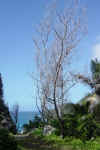 Calophyllum
inophyllum or takamaka is a common tree of the coastal vegetation from
Silhouette. Providing shade on its beaches as well as being good timber. It is a
nice evergreen tree growing mainly on deep coastal sands, usually with a short,
thick bole and spreading branches. It is resistant to salt water and for that
reason used to prevent beach erosion. Takamaka trees are since 1994 victim of
wilt desease, caused by a fungus and killing hundreds of trees on all Seychelles
islands. Due to this loss of trees erosion has free hand on the beaches of
Silhouette. Fortunately some trees seem to recover, and the worst should be over
now. Calophyllum
inophyllum or takamaka is a common tree of the coastal vegetation from
Silhouette. Providing shade on its beaches as well as being good timber. It is a
nice evergreen tree growing mainly on deep coastal sands, usually with a short,
thick bole and spreading branches. It is resistant to salt water and for that
reason used to prevent beach erosion. Takamaka trees are since 1994 victim of
wilt desease, caused by a fungus and killing hundreds of trees on all Seychelles
islands. Due to this loss of trees erosion has free hand on the beaches of
Silhouette. Fortunately some trees seem to recover, and the worst should be over
now.
Albizia
falcataria (syn. falcata) is introduced from Mauritius but originates from
tropical Asia. It has a smooth pale-grey bark and widespreading branches with
thiny leaves. It’s a very fast growing tree reaching more than 30 meters in
only a few years time dominating the hillsides and it can be found till high on
the mountain tops of Silhouette. It is a very agressive tree and a real danger
for the native forrest.
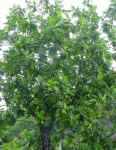 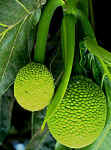 Artocarpus
altilis or breadfruit tree is spread all over the village La Passe.
A broad tree up to 20 m high with leaves 30-50 cm long that are thick, leathery
and lobed. The greenish seedless fruits are round, mealy and about 20-25 cm in
diameter. They are cooked or baked and used in the same way as potatoes.
Abundant on Silhouette but rarely used as food at the present. Artocarpus
altilis or breadfruit tree is spread all over the village La Passe.
A broad tree up to 20 m high with leaves 30-50 cm long that are thick, leathery
and lobed. The greenish seedless fruits are round, mealy and about 20-25 cm in
diameter. They are cooked or baked and used in the same way as potatoes.
Abundant on Silhouette but rarely used as food at the present.
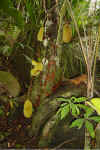 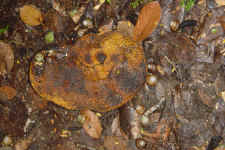
Artocarpus heterophyllus or jackfruit, originating from India, introduced
for its big fruits which reach more than 40 kilos but no longer eaten in the
Seychelles. It is the biggest tree-borne fruit in the world.Very
common in the forest, and a delicacy for the endemic land snails (right).
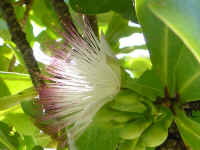 Barringtonia
asiatica or fish poison tree.
This tree can be found next to Gran Case. Before the flowers of this tree
were collected and used to catch fish. The flowers contain saponin, a drug
rendering fish inconspicious, when dropped in a rock pool, and make them
easy to catch. Barringtonia
asiatica or fish poison tree.
This tree can be found next to Gran Case. Before the flowers of this tree
were collected and used to catch fish. The flowers contain saponin, a drug
rendering fish inconspicious, when dropped in a rock pool, and make them
easy to catch.
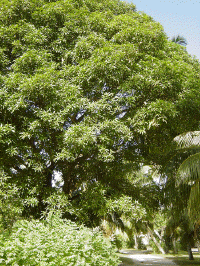 Mango
or Mangifera indica introduced for its fruits from South-East Asia. There
is a tree in the garden of the manager’s house. Mango
or Mangifera indica introduced for its fruits from South-East Asia. There
is a tree in the garden of the manager’s house.
Psidium
guayava or guava is a small tree about 10 meters high from tropical American
origin. Its fruit has the size and shape from a big lemon. There are a few of
these trees next to the hen house beside the guest house, and a little higher
than the small banana plantation on the way to Jardin Marron.
Musa
spec. or banana tree, both bananas as a fruit as well as bananas
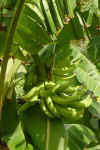 to cook or
bake grow on Silhouette. You can see them on the way to Jardin Marron or near
the mausoleum. to cook or
bake grow on Silhouette. You can see them on the way to Jardin Marron or near
the mausoleum.
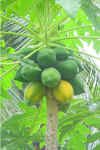 Carica
papaya in creol pawpaw. The papaya was first described by the Spanish
chronicler Oviedo in 1526 from the Caribbean coast of Panama and Colombia.This
herbevorious plant is abundant on Silhouette.A real forest of papaya trees grows on the dump behind the old
chicken farm on the way to Anse Cipaille. Carica
papaya in creol pawpaw. The papaya was first described by the Spanish
chronicler Oviedo in 1526 from the Caribbean coast of Panama and Colombia.This
herbevorious plant is abundant on Silhouette.A real forest of papaya trees grows on the dump behind the old
chicken farm on the way to Anse Cipaille.
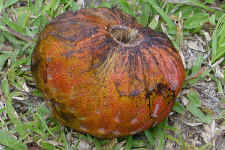 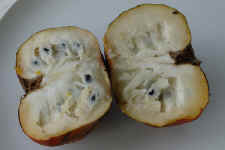 Ker-de-bef
in Creole, cherimoya or Annona cherimola is a South American tropical
fruit with the shape of a hart. Ker-de-bef comes from the French “coeur de
boeuf” or “cow hart”. It is a sweet creamy fruit. There is a small tree in
front of the coconut oven. Ker-de-bef
in Creole, cherimoya or Annona cherimola is a South American tropical
fruit with the shape of a hart. Ker-de-bef comes from the French “coeur de
boeuf” or “cow hart”. It is a sweet creamy fruit. There is a small tree in
front of the coconut oven.
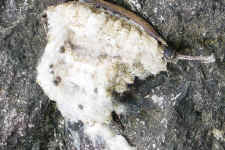 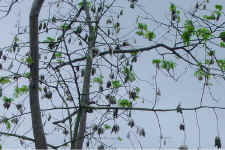 The
kapok tree or Ceiba pentandra is a fast growing tree reaching 40 meters.
The woody fruits contain a cotton like fiber simply called kapok fiber. There
stand two trees just after the split at the hospital to Jamaica on the right side
of the road. The
kapok tree or Ceiba pentandra is a fast growing tree reaching 40 meters.
The woody fruits contain a cotton like fiber simply called kapok fiber. There
stand two trees just after the split at the hospital to Jamaica on the right side
of the road. 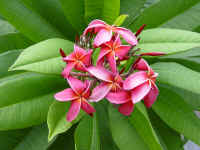 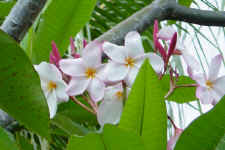 Frangipani
or Plumeria rubra is the red variety from the white Plumeria
obtusa. It is a small tree with fragrant flowers, the position of the petals
make the flowers look like a propeller. Used to decorate long drinks and
cocktails. Originating from the West-Indies. Can be found near the hotel area,
and all over the village. Frangipani
or Plumeria rubra is the red variety from the white Plumeria
obtusa. It is a small tree with fragrant flowers, the position of the petals
make the flowers look like a propeller. Used to decorate long drinks and
cocktails. Originating from the West-Indies. Can be found near the hotel area,
and all over the village.
Casuarina
equistifolia or pine tree. There is still discussion if this tree is introduced.
Probably not, seen this tree was already recorded in 1759. It is a fast growing
tree used on Mahé on the land winning areas. There are only a few on Silhouette, like
on the path to Anse Cimetiere, near the graveyard.
|
